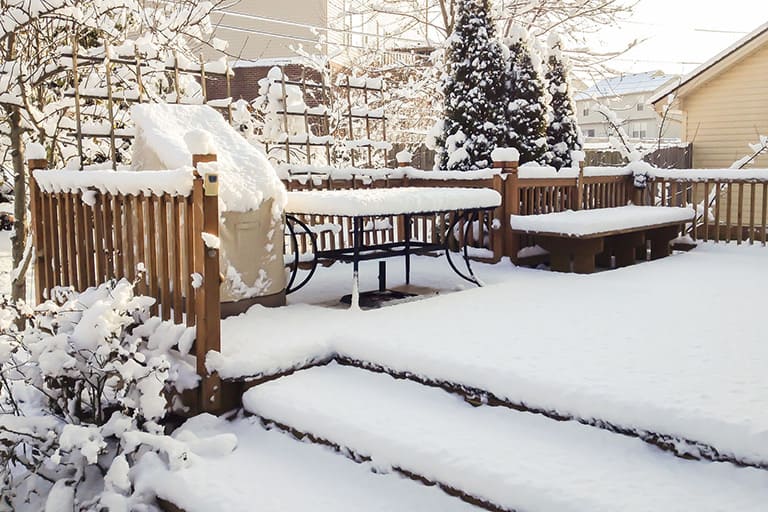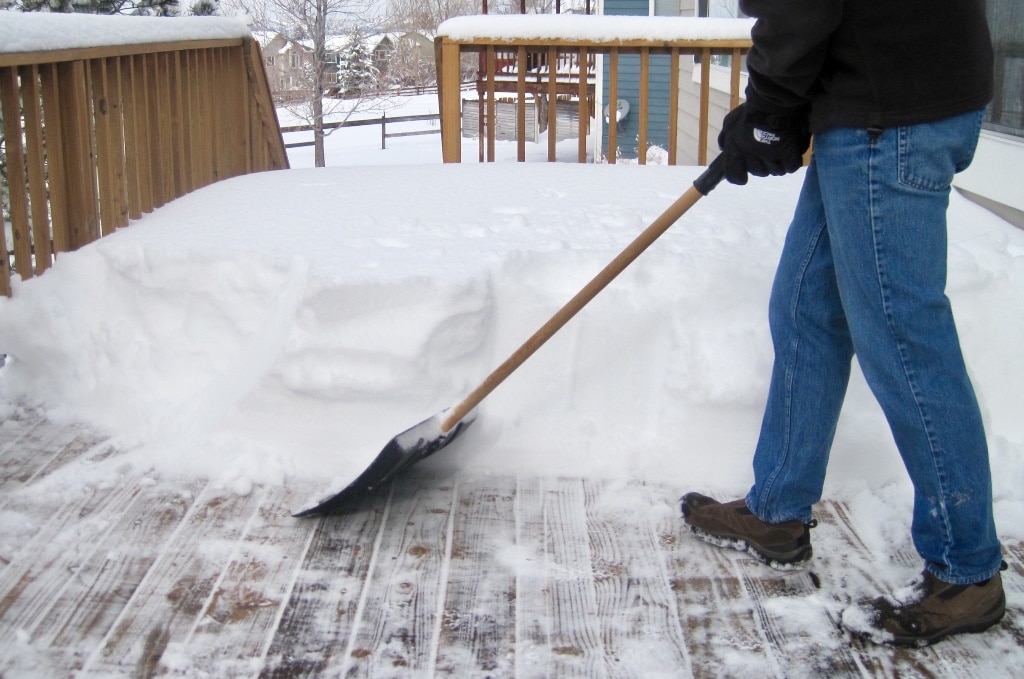For many, the idea of the winter season is synonymous with warm feelings: happy holidays, time spent indoors with family and friends, and warm, cozy nights cuddling next to the fire. The most wonderful time of the year!
For others, however, winter conjures dread at the idea of shoveling endless amounts of snow from walkways, scraping shards of ice from car windshields and worrying about what all that winter weather might damage on the home.
For those people, we offer a bit of respite from the woes of winter weather, at least where a wooden deck is concerned.

Will Ice and Snow Harm Your Deck?
If you’re concerned about the extra weight of snow and ice layers on your deck, you probably don’t have to worry. Building codes require a wood deck to support more weight than a roof, so if your deck was properly built and used quality deck board materials, you needn’t worry about defrosting it during winter. And as for cold temperatures and excess moisture, properly treated wood decks are incredibly resilient.
That said, if your deck is getting on in years or is especially well-traveled, keeping excess snow and ice off it certainly won’t hurt. Aside from preventing winter damage, you may need to keep things clean and clear for safety reasons. The last thing you want is to slip and fall when you’re taking out the garbage.
But don’t grab the ice pick just yet. While snow and ice may not harm your deck directly, you could damage it by attempting to remove those wintery concoctions without the right tools, techniques and preparation.
Preparing Your Deck for Winter Weather
The most important step to keeping your deck safe during winter should be before the first snowflakes fall. You may want to install snow-melting mats, buy snow blowers or keep away your deck furniture. Whatever precaution you take, checking and preparing your deck before a winter storm hits will go a long way toward cleaning off the ice when the time comes.
Clear Away Any Obstacles
Start with clearing out any objects that might pose obstacles once the ice and snow have fallen. Remove any furniture or fixtures, such as your backyard grill. If you don’t have a place to store them, you should cover them and move them to the side.
Also, make sure there aren’t any smaller obstacles in your deck’s wood, such as a protruding nail. These kinds of objects end up hidden by snow and ice, and you could snag them when you try to clean off your deck after winter.
Finally, it’s important to keep in mind that the objective here is safety. You only need to clear enough wintry precipitation to make a safe path across your wood deck.
Give Your Deck a Good Cleaning
Use warm, soapy water to give your deck a good cleaning. Be sure to clear out any debris, such as old leaves, mold, dirt and so on. This stuff can be a mess once the snow and ice melt and mix in with it.
Apply a Water-Resistant Seal
While not specific to winter weather, you may want to consider applying a fresh water-resistant seal if you haven’t done so in a while. A water-resistant wood deck helps to keep your outdoor living space safe from melt ice and snow. It also provides a slip-resistant deck surface so you do not have to worry about ice melt.
By taking just a few simple precautions to prepare your deck for winter, you ensure that the cleaning and removing snow process will be much simpler and safer. And your deck will be as beautiful as ever when the winter weather starts receding in the spring.
How to Remove Ice From Wood Decks
So you’ve taken the proper precautions for the inevitable blizzard that’s fallen on your wood deck, and now it’s here. Locks of snow and ice cover the landscape, and you need to clear a safe path to your backyard.
At this point, you need to remember that you aren’t dealing with a cement sidewalk. Even though you took all the necessary precautions, removing snow or ice from your wood decking requires a bit more care.
Start With a Broom
Believe it or not, a broom is one of the best tools you have to remove snow from your deck. A simple corn broom works wonders — the soft bristles won’t scrape or damage the wood. For light snow, you may not even need anything else. Remove ice and snow using the business end of your broom and retire to the fireplace, content with your ingenuity.

Shovel Smartly
You may need to pull out the heavy tools for heavier, wetter snow. If this is the case, leave the metal shovel in the toolshed. A metal shovel or other tools with sharp edges can cause serious damage to your deck’s wood, so use a rubber or plastic blade shovel.
When shoveling, be extra cautious. Even a plastic shovel blade can damage softer woods like redwood or cedar. Harder woods, such as pine and mahogany, are less vulnerable, but even the hardiest decks aren’t completely resistant to scratching. You don’t want to see something from a horror movie on your deck when the snow melts in the spring.
Your technique goes a long way here. Be mindful of the direction you shovel and push snow parallel to the deck boards. If you scoop perpendicular to the boards, you’ll catch the edges and leave chips and gouges, even with a rubber or plastic shovel.
Finally, leave a thin layer on your deck. Never depend on a shovel to get every last bit of snow off your deck. Even with the utmost care and the best tools, you’re likely to damage your deck. If the snow is soft enough, you can return to the broom to finish things. If you’re trying to remove ice from your deck boards, you’ll need to use a deicer to finish the job.
Using Deicers
When dealing with ice on your deck, there are a few things you’ll want to avoid. For starters, never use sand, gravel, cat litter or rocks to increase traction on your timber decking. While these materials are fine for your cement walkway, they can grind into the wood of your deck and cause unsightly damage. Use ice removal chemical solutions and deicers instead.
Chemical deicers are the best bet for melting ice and removing them from your deck boards, though you’ll want to avoid any with a dye. These dyes can stain the wood on your deck, permanently damaging it. You’ll also want to avoid using rock salt as it can dry your wood out and even cause the metal nails and screws in your deck to corrode.
There are numerous choices of deicers that are made specifically for wood decks. To prevent any lasting damage and ensure your deck remains beautiful, do yourself a favor and use one of the specialized deicers for your deck. You’ll thank yourself come springtime.
Clean and Safe Wooden Decks
There you have it — everything you ever needed to know about preparing for and safely dealing with the ice and snow accumulating on your deck. Remember to be cautious when shoveling and keep yourself and your family safe this winter season.

